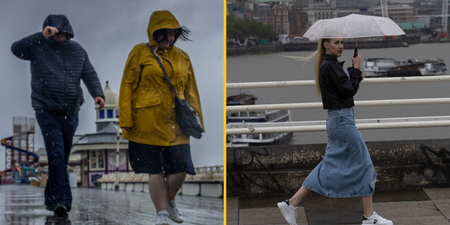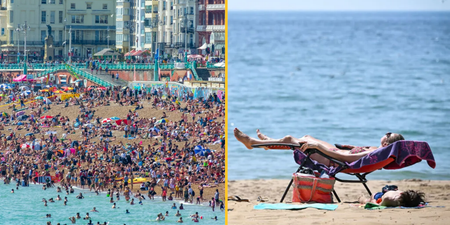Heavy thunderstorms are set to hit large parts of the country from Tuesday
Flash floods and thunderstorms will hit parts of the UK over the coming days, forecasters have warned.
Following weeks of non-stop sunshine and searingly hot conditions, heavy downpours are expected to hit large parts of the country, with warnings now in place.
The Met Office has issued an amber thunderstorm warning for areas of Cornwall, Devon and Somerset – with the likely chance of homes and businesses flooding, power cuts, and transport chaos.
Yellow warnings are also in place for most of the UK on Tuesday and for southern England on Wednesday.
A rather cloudy start to Tuesday morning with rain and showers in places ☁️🌧️🌦️
Feeling muggy for many, with thundery showers soon developing ⛈️ pic.twitter.com/WqRA56mt0G
— Met Office (@metoffice) August 15, 2022
Weeks of little rain and warm conditions have caused droughts across parts of the UK, leaving land parched.
According to the Met Office, July 2022 was the driest July for England since 1935, and the driest July on record for East Anglia, southeast and southern England.
England had just 35 per cent (23.1mm) of its average rainfall for the month, Wales 53 per cent (52mm), Northern Ireland 51 per cent (45.8mm) and Scotland topped the billing with 81 per cent (83.6mm).
Regions in the south and east were especially dry, with southern England reporting its driest July on record in a series that goes back to 1836, with 10.5mm of rain, which is just 17 per cent of its average rainfall.
In addition, 13 counties across southern and eastern England reported their driest July on record, including Hampshire, Surrey, Berkshire, Dorset and Kent.
🚨 | The UK saw low levels of rainfall in July with 46.3mm landing.
In more recent times we did see a dryer July across the UK in the 1970s and 1980s.
The lowest rainfall in July for the UK on record was in the 1860s according to Met Office data. pic.twitter.com/JD1EEotTRN
— Jamie Jenkins (@statsjamie) August 14, 2022
An experiment by a meteorologist has shown the effects of droughts – and how they increase the risk of flash floods after rainfall.
The video, made by Dr. Robert Thompson from the University of Reading, shows three glasses of water being poured on wet grass, moist grass and dry grass.
The experiment was carried out in Harris gardens, at the University of Reading.
The water from the first glass is absorbed into the ground in about ten seconds, the second almost 50, and the third takes so long that Dr. Thompson gives up.
Dr. Thompson explained that this is because dried out soil repels water rather than absorbing it, causing rain to pool on the surface.
He said: “Dry compacted soils repel water rather than letting it soak in as wet soil would.”
“This means rain pools on the surface and runoff rates increase – leading to a greater risk of flash flooding,” he continued.
He added: “Soil dryness has a serious negative impact on agriculture, especially if they cannot irrigate crops.”
The recovery of our soil is still up in the air, as according to Dr. Thompson it “entirely depends on the amount and types of rain that fall.”
There are heavy rains forecast for later on this week, but unfortunately according to forecasts they are the wrong type of rain to tackle the driest spell in almost 50 years.
The ideal type of rain is a light drizzle over several hours which is not the downpours that the Met Office has predicted to begin this week.
“With a world where droughts and intense rainfall are both expected to become more extreme, the combination becomes a greater threat.”
Although as of the 15th of August there are three active flood alerts in the UK, there is little that can be done to reduce this effect poses, according to Dr. Thompson.
“The best advice is to keep an eye on weather forecasts, sign up for warnings and make a flood plan.”
Related links:
- Dramatic moment cliff collapses on UK beach as hot weather scorches rocks
- World’s deadliest sharks could head to UK waters because of global warming, expert warns
- Bees may ejaculate themselves to death if heatwave reaches 42C
- The Earth is slowing down – and scientists don’t know why














































